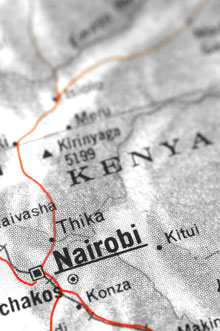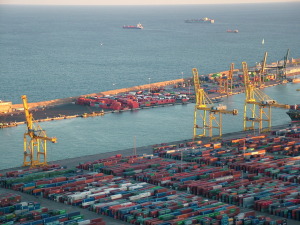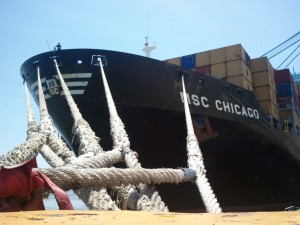 As we welcome the New Year, it is time for the African continent to take stock of developments in international trade policy that occurred in 2015. The year ended with the 10th Ministerial Conference of the World Trade Organization (WTO), which took place in Nairobi, Kenya from 15 to 19 December 2015, a first such meeting to be hosted by an African nation. The Conference was opened by Kenya’s President, Uhuru Kenyatta and hosted by Kenya’s Cabinet Secretary for Foreign Affairs and International Trade Amina Mohamed. They were joined at the Opening Ceremony by President Ellen Johnson Sirleaf of Liberia, whose country concluded its WTO membership negotiations on 16 December 2015. It is interesting to note that the round of trade negotiations being discussed in Nairobi, the Doha Development Agenda (Doha), was launched in Marakesh, Morroco in 2001.
As we welcome the New Year, it is time for the African continent to take stock of developments in international trade policy that occurred in 2015. The year ended with the 10th Ministerial Conference of the World Trade Organization (WTO), which took place in Nairobi, Kenya from 15 to 19 December 2015, a first such meeting to be hosted by an African nation. The Conference was opened by Kenya’s President, Uhuru Kenyatta and hosted by Kenya’s Cabinet Secretary for Foreign Affairs and International Trade Amina Mohamed. They were joined at the Opening Ceremony by President Ellen Johnson Sirleaf of Liberia, whose country concluded its WTO membership negotiations on 16 December 2015. It is interesting to note that the round of trade negotiations being discussed in Nairobi, the Doha Development Agenda (Doha), was launched in Marakesh, Morroco in 2001.
Customs & Trade Facilitation
Does Trade Facilitation Matter in the Fight against Corruption?
This post originally appeared on Richard Bistrong’s blog on August 3, 2015. View the original article here.
The World Trade Organization’s (WTO) Trade Facilitation Agreement (TFA) may seem to be an odd topic for an anti-corruption blog but it is not. It has everything to do with good governance and addressing the demand side of corruption at the border. But in order to understand the relationship one must understand what Trade Facilitation is and how exactly it addresses public corruption at Customs.
The WTO defines trade facilitation as “the simplification and harmonisation of international trade procedures” covering the “activities, practices and formalities involved in collecting, presenting, communicating and processing data required for the movement of goods in international trade.” The main features of the TFA include: required publication of regulations and fees; appeal-and-comment rights when new regulations are introduced; mandatory internet availability of documents and payment options; simple and clear access to overseas documents and regulations; special procedures for expedited release of air cargo and perishable goods; transit guarantees for cargoes from land-locked countries through neighboring countries to seaports without special fees; support for the use of express delivery and air cargo; requirements for clear procedures to deal with cargo holdups and releases; and technical assistance and capacity building for low-income countries to put these reforms into place. In short, TFA provides a blueprint for customs modernization. Successful implementation will lie in the detailed work that lies ahead.
The TFA was finalized at the conclusion of the 9th Ministerial Conference in Bali, Indonesia, on December 7, 2013 (see here). It was the first WTO trade agreement concluded since 1998 and the first fully multilateral trade agreement negotiated under the auspices of the WTO. Unfortunately, India held up final approval of the TFA by linkage to an entirely separate issue addressing food stockholding programs. Thanks to the leadership of Director-General Roberto Azevedo and persistent efforts of the U.S. Trade Representative Ambassador Michael Froman, on November 27, 2014 the WTO adopted decisions related to public stockholding for food security purposes, the TFA and the post-Bali work, which put TFA back on track for ratification and implementation.
In spite of the touted benefits, the WTO member countries has been slow to ratify the TFA. As of June 18, 2015, only eight countries had ratified. They include: the United States, Singapore, Hong Kong, Mauritius, Malaysia, Japan, Australia and Botswana. On July 14, 2015, the European Parliament’s INTA Committee approved TFA. Each European Union member state will be counted individually. Nonetheless, two-thirds of the WTO membership, or 108 members, must ratify TFA before it is implemented. Meanwhile, the U.S. and the WTO are encouraging countries to take action before the Tenth WTO Ministerial December 15-18, 2015 in Nairobi Kenya.
Deputy U.S. Trade Representative Bruce Hirsh also called on U.S. businesses with operations in developing countries to weigh in. Companies should view these reforms as a welcome opportunity to also combat public corruption at the border. Moreover, various countries are donating funds to technical assistance programs for developing countries. For example, on July 2, 2015 Australia donated AUD 1 million for the Trade Facilitation Agreement Facility and on July 27, 2015, Ireland donated EUR 350,000 for technical assistance.
The Organization for Economic Cooperation and Development estimates that the customs reforms effected by TFA implementation would lower the total trade cost of shipping goods by 10 to 15 percent depending upon the country. Some expect implementation of TFA’s measures to boost global trade by an estimated $1 trillion and global GDP by nearly 5 percent. As stated by the Office of the United States Trade Representative, “it makes it easier for businesses big and small to participate in trade around the world – and to support jobs through that trade.”
Various aspects of the Agreement, such as transparency, automated entry and payment of duties, can serve powerful measures to address corruption at Customs. Corruption at the border is undoubtedly a significant impediment to trade and investment in the developing world. Corruption at ports is such a serious problem that the maritime industry has organized a collective action effort called the Maritime Anti-Corruption Network (“MACN”) which seeks to “work toward its vision of a maritime industry free of corruption that enables fair trade to the benefit of society at large.”[1] It goes without question that TFA implementation would aid in this effort.
TFA implementation will also be a test of good governance. Countries will have to make the decision of whether they actually want to avail themselves of the donor assistance for capacity building to modernize their border processes. This can be seen as a test of whether a country is really willing to address corruption at Customs. A country’s willingness or unwillingness to adopt measures facilitating trade and reducing the opportunities for corruption at the border may be a powerful indicator of a culture of corruption – more so than any index of perception of corruption.
For companies doing business abroad, especially in emerging countries, a country that undertakes these reforms may be a better bet for business. And hopefully, the countries that take advantage of the assistance will succeed in establishing their places in the global value chain. In sum, TFA implementation should be an important tool in addressing the demand side of corruption and making the implementing country a more attractive and less risky place to do business.
Ms. Suarez is an experienced customs and international trade lawyer with a special focus on import regulation as well as on anti-corruption and trade policy issues. Her practice includes administrative, regulatory, legislative and litigation matters for global companies that are involved in importing, exporting, transportation, logistics, and customs brokerage. Ms. Suarez has also handled high-profile investigations, such as the U.N. Volcker Committee and various Congressional investigations into the U.N. Oil-for-Food Programme. She can be reached via e-mail at esuarez@suarezfirm.com and at 202.552.0310.
[1] http://www.bsr.org/en/our-work/working-groups/maritime-anti-corruption-network.
International Trade – The States Are Economic Stakeholders
 This appeared on AmericanLegislator.org on February 3, 2015.
This appeared on AmericanLegislator.org on February 3, 2015.
It is so widely accepted that citizens of countries embracing international trade fare better economically than citizens of countries that do not, it’s considered established fact. Open economies grow faster than closed economies. The World Bank has reported that per capita real income grew more than three times faster for developing countries that lowered trade barriers (5.0% per year) than other developing countries (1.4% per year) in the 1990s. [1] Think tanks from the Heritage Foundation to the Brookings Institution agree that freedom of international commerce in trade and services promotes economic development.
By reducing poverty, international trade also addresses some national security concerns. According the OECD, trade openness can be tangibly measured in terms of economic growth, productivity, a higher standard of living, further innovation, stronger institutions and infrastructure, and even the promotion of peace.
What Does the WTO Trade Facilitation Agreement Really Mean for Business?
 On November 27, 2014, the World Trade Organization (WTO) was finally able to overcome an impasse created by India in July which prevented implementation of the Trade Facilitation Agreement reached in Bali in December 7, 2013. As described by WTO Director General (DG) Azevedo, “the impasse related to the political link between two of the Bali decisions – the decision on Public Stockholding for Food Security Purposes, and the Trade Facilitation Agreement.” The WTO General Council was able to address India’s objections after a breakthrough made by the U.S. and India on November 13, 2014 to simultaneously adopt the protocol necessary to implement the TFA and a decision clarifying the terms of an existing food security “peace clause.”
On November 27, 2014, the World Trade Organization (WTO) was finally able to overcome an impasse created by India in July which prevented implementation of the Trade Facilitation Agreement reached in Bali in December 7, 2013. As described by WTO Director General (DG) Azevedo, “the impasse related to the political link between two of the Bali decisions – the decision on Public Stockholding for Food Security Purposes, and the Trade Facilitation Agreement.” The WTO General Council was able to address India’s objections after a breakthrough made by the U.S. and India on November 13, 2014 to simultaneously adopt the protocol necessary to implement the TFA and a decision clarifying the terms of an existing food security “peace clause.”
Trade Facilitation Agreement Is Back On Track

Because of an impasse created by India over food security this past July, which prevented ratification of the Trade Facilitation Agreement (TFA) reached in Bali in December 2013, some questioned the continued viability of the World Trade Organization. On Nov. 27, 2014, the WTO was finally able to overcome the deadlock and adopted the protocol of amendment which opened TFA for ratification and implementation.
The WTO General Council was able to address India’s objections after a breakthrough made by the U.S. and India on Nov. 13, 2014, to simultaneously adopt the protocol necessary to implement the TFA and a decision clarifying the terms of an existing food security “peace clause.” As stated by Director-General Roberto Azevedo, this was “a very important moment for the WTO” putting “negotiations back on track” and creating a “renewed commitment to the multilateral trading system.”
The protocol of amendment formally inserts the TFA into the WTO rulebook, according to Director-General Azevedo. This clears the way for the TFA to come into force. However, it also removes the July 31, 2015, deadline for WTO members to ratify the TFA leaving open the ratification process open indefinitely. The agreement enters into force once two-thirds of WTO members have completed their domestic ratification process.
So what does this first WTO multilateral agreement mean to the global economy, the developing world and international business? U.S. Trade Representative Ambassador Michael Froman says that “[t]he Trade Facilitation Agreement has the potential to fundamentally reform global customs practices and substantially reduce the costs and time associated with goods crossing borders. It’s a perfect example of how breaking down barriers to trade can unlock new opportunities for developed and developing countries alike, and it’s a particularly important win for small- and medium-sized businesses in all countries.” It is no wonder why TFA implementation is strongly supported by groups like the International Chamber of Commerce.
What does the TFA do? The agreement simplifies and harmonizes customs procedures and mandates customs reforms such as introducing transparency, risk based management by customs administrations, a “single window” for all government agencies dealing with imported merchandise, automation, electronic payment of duties and the separation of the payment of duties from the release of cargo, among other things. These improvements are intended to facilitate trade across borders, thereby reducing the costs for international traders and ultimately consumers.
The agreement also offers donor assistance and capacity building to developing and least developing countries so that they can enjoy the well-documented benefits of implementation. The improved trading environment should attract more trade and investment to countries that implement good governance in the form the improved customs procedures. The improvements, which have the effect of increasing transparency and reducing discretion of customs officials, should also address corruption at the border at least to some extent.
So what impact will the customs modernization reforms contained in the TFA have? What does this mean to business engaged in global trade and foreign direct investment? It should introduce an element of predictability in the form of rule of law and good governance for business embarking on what heretofore were riskier trading endeavors. It should take some of the risk out of doing business in emerging markets, where it is said that some of the greatest business opportunities lie. Perhaps even small- and medium-sized businesses will venture out into these markets stimulating the global economy and presenting a win-win for the developed and developing worlds as predicted by Ambassador Froman.
There is much work to be done. The argument must be made that ratification is in each country’s best interest. Countries must be proactive to avail themselves of the assistance offered by donor organizations like the World Bank, World Customs Organization and the WTO, whose Trade Facilitation Agreement Facility is now operational with the finalization of the agreement. Each country must prioritize its most important customs reforms and donor organizations must coordinate efforts to avoid wasting valuable resources. Business can also make their priorities known to the governments and donor organizations on areas of importance to business and what needs to be addressed first in particular countries. As Director-General Azevedo states, now the “real work begins.”
